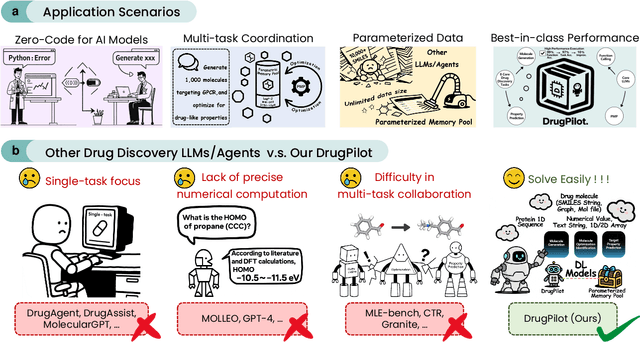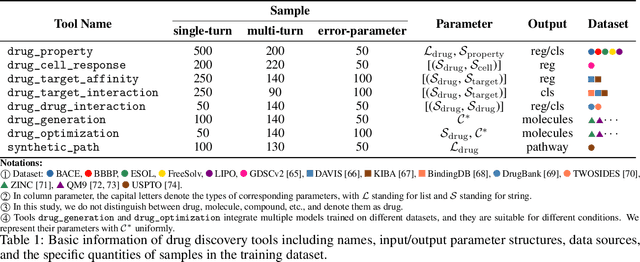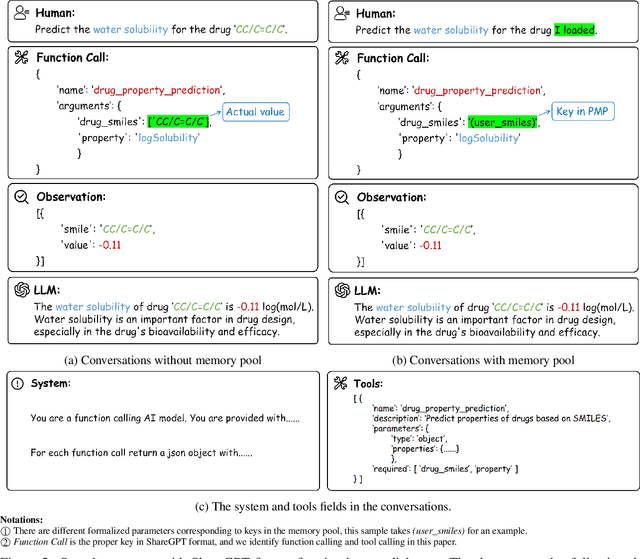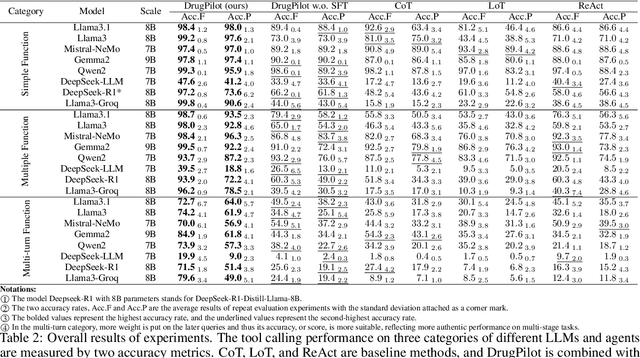Kun Li
DyCrowd: Towards Dynamic Crowd Reconstruction from a Large-scene Video
Aug 18, 2025Abstract:3D reconstruction of dynamic crowds in large scenes has become increasingly important for applications such as city surveillance and crowd analysis. However, current works attempt to reconstruct 3D crowds from a static image, causing a lack of temporal consistency and inability to alleviate the typical impact caused by occlusions. In this paper, we propose DyCrowd, the first framework for spatio-temporally consistent 3D reconstruction of hundreds of individuals' poses, positions and shapes from a large-scene video. We design a coarse-to-fine group-guided motion optimization strategy for occlusion-robust crowd reconstruction in large scenes. To address temporal instability and severe occlusions, we further incorporate a VAE (Variational Autoencoder)-based human motion prior along with a segment-level group-guided optimization. The core of our strategy leverages collective crowd behavior to address long-term dynamic occlusions. By jointly optimizing the motion sequences of individuals with similar motion segments and combining this with the proposed Asynchronous Motion Consistency (AMC) loss, we enable high-quality unoccluded motion segments to guide the motion recovery of occluded ones, ensuring robust and plausible motion recovery even in the presence of temporal desynchronization and rhythmic inconsistencies. Additionally, in order to fill the gap of no existing well-annotated large-scene video dataset, we contribute a virtual benchmark dataset, VirtualCrowd, for evaluating dynamic crowd reconstruction from large-scene videos. Experimental results demonstrate that the proposed method achieves state-of-the-art performance in the large-scene dynamic crowd reconstruction task. The code and dataset will be available for research purposes.
Motion Matters: Motion-guided Modulation Network for Skeleton-based Micro-Action Recognition
Jul 29, 2025Abstract:Micro-Actions (MAs) are an important form of non-verbal communication in social interactions, with potential applications in human emotional analysis. However, existing methods in Micro-Action Recognition often overlook the inherent subtle changes in MAs, which limits the accuracy of distinguishing MAs with subtle changes. To address this issue, we present a novel Motion-guided Modulation Network (MMN) that implicitly captures and modulates subtle motion cues to enhance spatial-temporal representation learning. Specifically, we introduce a Motion-guided Skeletal Modulation module (MSM) to inject motion cues at the skeletal level, acting as a control signal to guide spatial representation modeling. In parallel, we design a Motion-guided Temporal Modulation module (MTM) to incorporate motion information at the frame level, facilitating the modeling of holistic motion patterns in micro-actions. Finally, we propose a motion consistency learning strategy to aggregate the motion cues from multi-scale features for micro-action classification. Experimental results on the Micro-Action 52 and iMiGUE datasets demonstrate that MMN achieves state-of-the-art performance in skeleton-based micro-action recognition, underscoring the importance of explicitly modeling subtle motion cues. The code will be available at https://github.com/momiji-bit/MMN.
RESCUE: Crowd Evacuation Simulation via Controlling SDM-United Characters
Jul 27, 2025



Abstract:Crowd evacuation simulation is critical for enhancing public safety, and demanded for realistic virtual environments. Current mainstream evacuation models overlook the complex human behaviors that occur during evacuation, such as pedestrian collisions, interpersonal interactions, and variations in behavior influenced by terrain types or individual body shapes. This results in the failure to accurately simulate the escape of people in the real world. In this paper, aligned with the sensory-decision-motor (SDM) flow of the human brain, we propose a real-time 3D crowd evacuation simulation framework that integrates a 3D-adaptive SFM (Social Force Model) Decision Mechanism and a Personalized Gait Control Motor. This framework allows multiple agents to move in parallel and is suitable for various scenarios, with dynamic crowd awareness. Additionally, we introduce Part-level Force Visualization to assist in evacuation analysis. Experimental results demonstrate that our framework supports dynamic trajectory planning and personalized behavior for each agent throughout the evacuation process, and is compatible with uneven terrain. Visually, our method generates evacuation results that are more realistic and plausible, providing enhanced insights for crowd simulation. The code is available at http://cic.tju.edu.cn/faculty/likun/projects/RESCUE.
Adaptive Termination for Multi-round Parallel Reasoning: An Universal Semantic Entropy-Guided Framework
Jul 09, 2025Abstract:Recent advances in large language models (LLMs) have accelerated progress toward artificial general intelligence, with inference-time scaling emerging as a key technique. Contemporary approaches leverage either sequential reasoning (iteratively extending chains of thought) or parallel reasoning (generating multiple solutions simultaneously) to scale inference. However, both paradigms face fundamental limitations: sequential scaling typically relies on arbitrary token budgets for termination, leading to inefficiency or premature cutoff; while parallel scaling often lacks coordination among parallel branches and requires intrusive fine-tuning to perform effectively. In light of these challenges, we aim to design a flexible test-time collaborative inference framework that exploits the complementary strengths of both sequential and parallel reasoning paradigms. Towards this goal, the core challenge lies in developing an efficient and accurate intrinsic quality metric to assess model responses during collaborative inference, enabling dynamic control and early termination of the reasoning trace. To address this challenge, we introduce semantic entropy (SE), which quantifies the semantic diversity of parallel model responses and serves as a robust indicator of reasoning quality due to its strong negative correlation with accuracy...
Vision-based Lifting of 2D Object Detections for Automated Driving
Jun 13, 2025Abstract:Image-based 3D object detection is an inevitable part of autonomous driving because cheap onboard cameras are already available in most modern cars. Because of the accurate depth information, currently, most state-of-the-art 3D object detectors heavily rely on LiDAR data. In this paper, we propose a pipeline which lifts the results of existing vision-based 2D algorithms to 3D detections using only cameras as a cost-effective alternative to LiDAR. In contrast to existing approaches, we focus not only on cars but on all types of road users. To the best of our knowledge, we are the first using a 2D CNN to process the point cloud for each 2D detection to keep the computational effort as low as possible. Our evaluation on the challenging KITTI 3D object detection benchmark shows results comparable to state-of-the-art image-based approaches while having a runtime of only a third.
* https://ieeexplore.ieee.org/document/9190325
Say What You Mean: Natural Language Access Control with Large Language Models for Internet of Things
May 28, 2025Abstract:Access control in the Internet of Things (IoT) is becoming increasingly complex, as policies must account for dynamic and contextual factors such as time, location, user behavior, and environmental conditions. However, existing platforms either offer only coarse-grained controls or rely on rigid rule matching, making them ill-suited for semantically rich or ambiguous access scenarios. Moreover, the policy authoring process remains fragmented: domain experts describe requirements in natural language, but developers must manually translate them into code, introducing semantic gaps and potential misconfiguration. In this work, we present LACE, the Language-based Access Control Engine, a hybrid framework that leverages large language models (LLMs) to bridge the gap between human intent and machine-enforceable logic. LACE combines prompt-guided policy generation, retrieval-augmented reasoning, and formal validation to support expressive, interpretable, and verifiable access control. It enables users to specify policies in natural language, automatically translates them into structured rules, validates semantic correctness, and makes access decisions using a hybrid LLM-rule-based engine. We evaluate LACE in smart home environments through extensive experiments. LACE achieves 100% correctness in verified policy generation and up to 88% decision accuracy with 0.79 F1-score using DeepSeek-V3, outperforming baselines such as GPT-3.5 and Gemini. The system also demonstrates strong scalability under increasing policy volume and request concurrency. Our results highlight LACE's potential to enable secure, flexible, and user-friendly access control across real-world IoT platforms.
RAG-Zeval: Towards Robust and Interpretable Evaluation on RAG Responses through End-to-End Rule-Guided Reasoning
May 28, 2025



Abstract:Robust evaluation is critical for deploying trustworthy retrieval-augmented generation (RAG) systems. However, current LLM-based evaluation frameworks predominantly rely on directly prompting resource-intensive models with complex multi-stage prompts, underutilizing models' reasoning capabilities and introducing significant computational cost. In this paper, we present RAG-Zeval (RAG-Zero Evaluator), a novel end-to-end framework that formulates faithfulness and correctness evaluation as a rule-guided reasoning task. Our approach trains evaluators with reinforcement learning, facilitating compact models to generate comprehensive and sound assessments with detailed explanation in one-pass. We introduce a ranking-based outcome reward mechanism, using preference judgments rather than absolute scores, to address the challenge of obtaining precise pointwise reward signals. To this end, we synthesize the ranking references by generating quality-controlled responses with zero human annotation. Experiments demonstrate RAG-Zeval's superior performance, achieving the strongest correlation with human judgments and outperforming baselines that rely on LLMs with 10-100 times more parameters. Our approach also exhibits superior interpretability in response evaluation.
SwarmThinkers: Learning Physically Consistent Atomic KMC Transitions at Scale
May 26, 2025Abstract:Can a scientific simulation system be physically consistent, interpretable by design, and scalable across regimes--all at once? Despite decades of progress, this trifecta remains elusive. Classical methods like Kinetic Monte Carlo ensure thermodynamic accuracy but scale poorly; learning-based methods offer efficiency but often sacrifice physical consistency and interpretability. We present SwarmThinkers, a reinforcement learning framework that recasts atomic-scale simulation as a physically grounded swarm intelligence system. Each diffusing particle is modeled as a local decision-making agent that selects transitions via a shared policy network trained under thermodynamic constraints. A reweighting mechanism fuses learned preferences with transition rates, preserving statistical fidelity while enabling interpretable, step-wise decision making. Training follows a centralized-training, decentralized-execution paradigm, allowing the policy to generalize across system sizes, concentrations, and temperatures without retraining. On a benchmark simulating radiation-induced Fe-Cu alloy precipitation, SwarmThinkers is the first system to achieve full-scale, physically consistent simulation on a single A100 GPU, previously attainable only via OpenKMC on a supercomputer. It delivers up to 4963x (3185x on average) faster computation with 485x lower memory usage. By treating particles as decision-makers, not passive samplers, SwarmThinkers marks a paradigm shift in scientific simulation--one that unifies physical consistency, interpretability, and scalability through agent-driven intelligence.
DrugPilot: LLM-based Parameterized Reasoning Agent for Drug Discovery
May 20, 2025



Abstract:In the field of AI4Science, large-scale language models (LLMs) show great potential to parse complex scientific semantics, integrate cross-disciplinary knowledge, and assist critical task research. However, in the field of drug discovery, despite the optimization through professional data pre-training, context window expansion, and internet search, the existing LLMs are still facing challenges such as massive multi-modal and heterogeneous data processing, domain knowledge dynamic updating delay, and insufficient confidence in predicting the results of complex computational tasks. To address these challenges, we propose the DrugPilot, an LLM-based agent with parameterized reasoning for drug discovery. DrugPilot addresses key limitations of traditional end-to-end LLM prediction approaches through its parametric inference architecture. This agent system supports major phases of the drug discovery pipeline, facilitating automated planning and execution of multi-stage research tasks. To address the critical challenge of multi-modal drug data analysis (incorporating both public datasets and user-submitted data), we developed an interactive parameterized memory pool. This innovative component standardizes real-world drug data into parametric representations, simultaneously enabling efficient knowledge retrieval in multi-turn dialogue while mitigating the information loss inherent in text-based data transmission. Additionally, we created a drug instruct dataset across 8 essential drug discovery tasks for model fine-tuning and evaluation. Based on the Berkeley function calling evaluation framework, DrugPilot demonstrated the most advanced tool calling capabilities on our drug discovery tool instruction dataset, outperforming existing agents (e.g., ReAct, LoT). Specifically, it achieves task completion rates of 98.0%, 93.5%, and 64.0% on simple, multiple, and multi-turn tasks, respectively.
Optimizing Multi-Round Enhanced Training in Diffusion Models for Improved Preference Understanding
Apr 25, 2025Abstract:Generative AI has significantly changed industries by enabling text-driven image generation, yet challenges remain in achieving high-resolution outputs that align with fine-grained user preferences. Consequently, multi-round interactions are necessary to ensure the generated images meet expectations. Previous methods enhanced prompts via reward feedback but did not optimize over a multi-round dialogue dataset. In this work, we present a Visual Co-Adaptation (VCA) framework incorporating human-in-the-loop feedback, leveraging a well-trained reward model aligned with human preferences. Using a diverse multi-turn dialogue dataset, our framework applies multiple reward functions, such as diversity, consistency, and preference feedback, while fine-tuning the diffusion model through LoRA, thus optimizing image generation based on user input. We also construct multi-round dialogue datasets of prompts and image pairs aligned with user intent. Experiments demonstrate that our method outperforms state-of-the-art baselines, significantly improving image consistency and alignment with user intent. Our approach consistently surpasses competing models in user satisfaction, especially in multi-turn dialogue scenarios.
 Add to Chrome
Add to Chrome Add to Firefox
Add to Firefox Add to Edge
Add to Edge